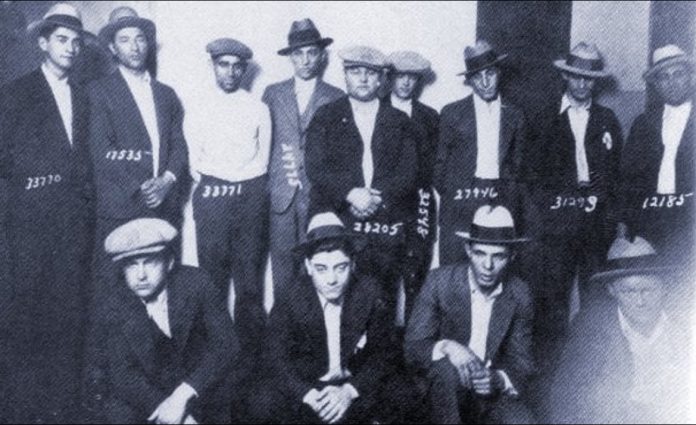The history of organised crime in the United States is a complex tapestry of violence, power struggles, and criminal enterprise. Two groups stand out as the most influential and feared: the Italian-American Mafia and Jewish mobsters. Both were responsible for some of the most brutal acts of violence, extortion, and murder in American history. This article delves deeper into their activities, comparing their methods, scale, and impact to determine which group had the worst record.
The Italian-American Mafia: A Culture of Violence and Omertà
The Italian-American Mafia, also known as La Cosa Nostra (“Our Thing”), was a highly organised criminal network with a strict hierarchy and code of conduct. Its roots trace back to Sicilian and Italian immigrants who brought their traditions of secrecy and loyalty to the United States. The Mafia’s influence peaked during the mid-20th century, with the “Five Families” of New York (Gambino, Genovese, Lucchese, Colombo, and Bonanno) dominating organised crime.
Violence and Murder
The Italian Mafia’s use of violence was both systematic and brutal. Murders were often carried out to eliminate rivals, enforce loyalty, or send a message. Some of the most infamous examples include:
- The St. Valentine’s Day Massacre (1929): Orchestrated by Al Capone’s Chicago Outfit, this massacre saw seven members of the rival North Side Gang gunned down in a garage. The brutality of the killings shocked the nation and cemented Capone’s reputation as a ruthless mob boss.
- The Assassination of Paul Castellano (1985): Ordered by John Gotti, the head of the Gambino family, this hit was carried out in broad daylight outside a steakhouse in Manhattan. Castellano’s murder marked a shift in the Mafia’s power dynamics and demonstrated the lengths to which mobsters would go to seize control.
- Internal Wars: The Italian Mafia was no stranger to internal violence. The Colombo family, for instance, experienced two bloody internal wars in the 1970s and 1990s, resulting in the deaths of dozens of members. These conflicts were often sparked by power struggles or disputes over money.
Extortion and Racketeering
The Italian Mafia’s ability to infiltrate legitimate businesses and labour unions was unparalleled. They used extortion, threats, and violence to control industries such as construction, waste management, and trucking. For example:
- The Lucchese Family: This family was deeply involved in labour racketeering, particularly in the garment industry. They extorted money from businesses and unions, often using violence to ensure compliance.
- The Genovese Family: Known as the “Ivy League” of organised crime, the Genovese family was involved in a wide range of criminal activities, including illegal gambling, loan sharking, and extortion. Their operations were so sophisticated that they often avoided prosecution for years.
Longevity and Influence
The Italian Mafia’s influence persisted well into the late 20th century, thanks to its strict code of silence (omertà) and ability to adapt to changing circumstances. While law enforcement eventually made significant strides in dismantling the Mafia, its legacy of violence and corruption remains deeply ingrained in American society.
Jewish Mobsters: Ruthless Innovators of Crime
Jewish mobsters played a significant role in organised crime during the early 20th century, particularly in New York City. While they lacked the formal structure of the Italian Mafia, they were equally ruthless and innovative in their criminal activities. Key figures like Arnold Rothstein, Meyer Lansky, and Louis Buchalter left an indelible mark on the history of American crime.
Violence and Murder
Jewish mobsters were responsible for some of the most shocking acts of violence in American criminal history. One of the most infamous examples is Murder, Inc., a enforcement arm of the National Crime Syndicate that carried out hundreds of contract killings. Key details include:
- Louis “Lepke” Buchalter: As the head of Murder, Inc., Buchalter was directly responsible for numerous murders. He was eventually executed in 1944, making him the only major mob boss to meet this fate.
- The Dutch Schultz Hit (1935): Jewish mobsters, in collaboration with Italian gangsters, orchestrated the assassination of Dutch Schultz, a powerful but erratic gangster. The hit was ordered by the National Crime Syndicate to prevent Schultz from carrying out a reckless plan to kill prosecutor Thomas Dewey.
Extortion and Racketeering
Jewish mobsters were heavily involved in extortion, particularly in industries like the garment trade and labour unions. They also played a key role in bootlegging during Prohibition. Key figures include:
- Arnold Rothstein: Often called the “father of organised crime” in America, Rothstein was a mastermind of illegal gambling and bootlegging. He was also instrumental in fixing the 1919 World Series, a scandal that rocked the sports world.
- Meyer Lansky: Known as the “Mob’s Accountant,” Lansky was a financial genius who helped create the National Crime Syndicate. While he preferred to avoid violence, he was deeply involved in illegal gambling, money laundering, and extortion.
Decline of Jewish Organised Crime
By the 1930s, the influence of Jewish mobsters began to wane. Many second-generation Jewish immigrants chose to pursue legitimate careers, and increased law enforcement pressure further weakened their operations. While Jewish gangs were highly effective in their prime, their lack of a formal structure and reliance on alliances with Italian mobsters limited their long-term impact.
Comparing the Two: Who Had the Worst Record?
When comparing Italian and Jewish mobsters, several factors stand out:
- Scale of Violence: The Italian Mafia’s violence was more systematic and widespread. Their internal wars, public massacres, and countless contract killings demonstrate a consistent pattern of brutality over decades. Jewish mobsters, while equally ruthless, operated on a smaller scale.
- Extortion and Influence: The Italian Mafia’s ability to infiltrate legitimate businesses and labour unions gave them a level of influence that Jewish mobsters never achieved. Their control over industries like construction and waste management allowed them to amass significant wealth and power.
- Longevity: The Italian Mafia’s influence persisted well into the late 20th century, while Jewish organised crime declined after the 1930s. This longevity allowed Italian mobsters to commit more crimes over a longer period.
That said, Jewish mobsters like Louis Buchalter and Meyer Lansky were responsible for some of the most shocking acts of violence and criminal ingenuity in American history. Their role in the creation of Murder, Inc. and their involvement in high-profile crimes cannot be overlooked.







